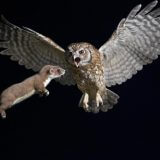What happens when humans try to “fix” nature… and fail spectacularly? The mongoose invasion in Hawaii is one of the most disastrous examples of ecological mismanagement. Originally introduced to control rat populations, these cunning predators instead turned their attention to native species, wreaking havoc on the delicate Hawaiian ecosystem. Today, the consequences of this failed experiment are still unfolding, leaving conservationists scrambling to mitigate the damage.
Add Impressive Nature New Tab theme for Google Chrome and enjoy awe-inspiring beauty of animals, flowers, and nature landscapes every time you open a new tab.
The Rat Problem: Hawaii’s Unintended Pest Crisis

Hawaii’s troubles began with the arrival of European ships in the late 1700s. Along with explorers and traders came rats, which quickly spread across the islands, feasting on crops and native bird eggs. The rapidly growing rat population posed a major threat to agriculture and biodiversity, prompting desperate attempts to find a solution.
The Introduction of Mongooses: A Well-Intended Disaster

In the late 1800s, plantation owners in Hawaii sought an answer to the rat problem. Inspired by successful cases in the Caribbean, they imported small Indian mongooses (Herpestes javanicus) from Jamaica, believing these predators would curb the rat population. However, their plan had a fatal flaw:
- Rats are nocturnal, while mongooses are diurnal. They rarely encountered each other, making the plan ineffective from the start.
- Instead of controlling rats, mongooses turned their predatory instincts toward Hawaii’s native species.
- The mongoose population exploded due to a lack of natural predators on the islands.
The Devastating Impact on Hawaii’s Wildlife
The mongoose invasion in Hawaii had dire consequences. With their sharp teeth and quick reflexes, mongooses became relentless hunters of small animals. Their impact on Hawaii’s unique ecosystem has been catastrophic:
1. Threat to Native Birds
Hawaii is home to many endemic bird species, including the Hawaiian petrel, nene goose, and Hawaiian crow. Mongooses raid nests, devouring eggs and hatchlings, leading to severe population declines. Some species are now critically endangered or extinct in the wild due to predation.
2. Destruction of Reptile Populations
Native lizards and sea turtles have also suffered. Mongooses prey on Hawaiian green sea turtle hatchlings, making it even harder for this already vulnerable species to survive. Skinks and geckos, which play vital roles in the ecosystem, have also seen significant population declines.
3. Impact on Small Mammals
While Hawaii lacks many native land mammals, the few that exist, such as the Hawaiian hoary bat, face increased predation. This further disrupts the balance of the island’s fragile ecosystem.
Ongoing Efforts to Control the Mongoose Invasion
Scientists, conservationists, and local authorities have taken action to limit the mongoose’s destruction:
- Trapping and Eradication Programs: Efforts to remove mongooses from critical habitats are ongoing. Some island areas, such as Kauai and Lana’i, have remained mongoose-free due to strict monitoring.
- Fencing and Protected Zones: Wildlife sanctuaries and nesting sites are being secured with mongoose-proof fencing to protect vulnerable species.
- Public Awareness and Conservation Programs: Education campaigns encourage residents and visitors to support conservation efforts by reporting sightings and avoiding actions that could aid mongoose survival.
Can Hawaii Recover from This Environmental Disaster?
The mongoose invasion in Hawaii serves as a powerful lesson in the unintended consequences of human intervention. While efforts to control mongooses continue, the damage to native wildlife may never be fully reversed. However, conservation initiatives offer hope for preserving what remains of Hawaii’s fragile ecosystem.
The introduction of mongooses to Hawaii was a well-intended but disastrous mistake. Instead of solving the rat problem, it created a new environmental crisis, threatening native birds, reptiles, and small mammals. Though eradication efforts are in place, the long-term impact of the mongoose invasion in Hawaii serves as a cautionary tale about the dangers of interfering with nature without fully understanding the consequences.











